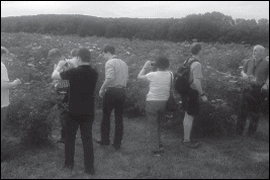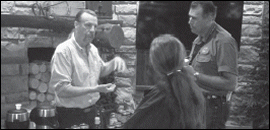Green Horizons
Volume 17, Number 2Summer 2013
By Katie Moritz, MU Center for Agroforestry Intern
Fledgling St. Louisan elderberry grower Joe Johnson came to the first ever International Symposium on Elderberry with one directive in mind: to develop his unique elderberry product idea. But what that idea is, he wouldn't say.
 |
| Symposium attendees check out elderberry plants before dinner at Natureís Organic Haven Farm in Hermann |
"If I tell you, someone will steal my idea," Johnson said, laughing.
Johnson did say his product will make use of the elderberry flowers rather than the berries. Since this is his first year harvesting, he said, he still has a lot to learn. The most interesting thing he picked up from the symposium was the European method of elderberry growing, which differs from the method used in North America.
Johnson was one of about 120 elderberry growers, scientists and enthusiasts that descended on Columbia for the symposium, June 9-14. The event, a multinational collaboration led by MU's Andrew Thomas, was convened under the auspices of the International Society of Horticulture Science. Presentations took place at Stoney Creek Inn and featured more than 60 talks on elderberries given by experts from over 10 different countries, including the US, Canada, Israel, Denmark, Hungary and Germany. Sessions focused on a wide array of topics including: Elderberry and Human Health, Biochemistry, Horticulture, Botany and Ethnobotany, Markets and Industry. Research papers presented at the Symposium will be published in a peer-reviewed volume of Acta Horticulturae.
Throughout the week, attendees took trips to the Missouri Botanical Gardens in St. Louis, Eridu Farms in Hartsburg and Nature's Organic Haven Farm in Hermann, where a dinner party was held.
Speaker highlights included the keynote talk, "Pharmacological and Clinical Effects of Elderberry Fruit," by Dr. Sigrun Chrubasik, of the University of Freiberg in Germany. She spoke about the potential for elderberry as a treatment for viruses such as herpes and HIV. There are also studies showing elderberry as a protection against the flu. Although the science is far from proven, the berry has a lot of potential uses, she said.
Denis Charlebois, of Agriculture and Agri-Food Canada, presented his talk "Did You Say Elderberry? Some Pitfalls to Avoid," about common elderberry misconceptions. He joked about the diversity of the symposium's attendees: "I don't know how much you paid to be here, but so far you have heard a German accent, a Danish accent and now a French-Canadian accent. It's quite unusual." He said people often ask the same questions over and over about elderberry: "What does it taste like? Is it poisonous?" "Taste it and you will see!" Charlebois joked.
Successful businessman Sylvain Mercier spoke about the elderberry company he developed and runs with his wife, Jacinthe Desmarais. SURO, a medicinal product that comes in syrup and salve forms, is sold across Canada and online. Mercier emphasized how important it was to effectively market his product and make it look professional. He even entered an agreement with his bottler so SURO would be the only product on the market with its packaging, he said.
"If you have bad quality, you will get bad feedback," Mercier said. "If [consumers] don't like it, they'll tell a lot of people. Don't make the mistake of buying cheap to save money."
Scientific presentations were given by MU researchers from the Center for Agroforestry, Division of Plant Sciences, Center for Botanical Interaction Studies, Division of Animal Sciences and Biochemistry. The Center for Agroforestry was well-represented, with presentations by Dr. Mike Gold, Ina Cernusca and Dr. Chung-Ho Lin.
Gold presented on the elderberry decision support tool available free on the center website. The tool helps growers determine financial outcomes depending on decisions they make about irrigation, pest control and other variables, Gold said. Growers can adjust the tool based on their own experiences. The tool is meant to show how much money a grower could make in different situations, and how long it would take for a grower to make a profit.
"We want this to reflect the reality of the grower so it's a useful tool," he said.
Lin spoke on the health benefits of bioactive phytochemicals in eastern redcedar, including as a potential treatment for melanoma. Redcedar also has phytochemicals with anti-MRSA properties. While Lin's research was conducted on eastern redcedar, the approach could have crossover potential to the study of elderberry.
 |
| Rodger Lenhardt of Normís Farm in North Carolina speaks with a couple attendees about his products during a break at the symposium. |
Cernusca focused on elderberry marketing. She led a research team that conducted a study on the elderberry market. The 74 survey respondents reported on their challenges for entry into this market. Many of them said there was a lack of interest and/or knowledge of elderberry by the public and also by lenders, making it hard to get startup loans. There is also a shortage of available fruit, and the equipment required to process elderberries can be expensive, she said. However, if farmers already produce other crops and can use that equipment for elderberry production, this can lower the cost of entry into the market. Another aspect of the current elderberry market entry is that there is low competition within the industry. New entrants help grow the market and can differentiate through innovation, she said. In conclusion, she mentioned that the industry is in its infancy but growing rapidly. Although there are many parttime participants and hobbyists at the present time, the few large-scale producers play an important role in growing the industry for the benefit of all market participants.
"Everybody is learning by doing and going through trial by error," Cernusca said.